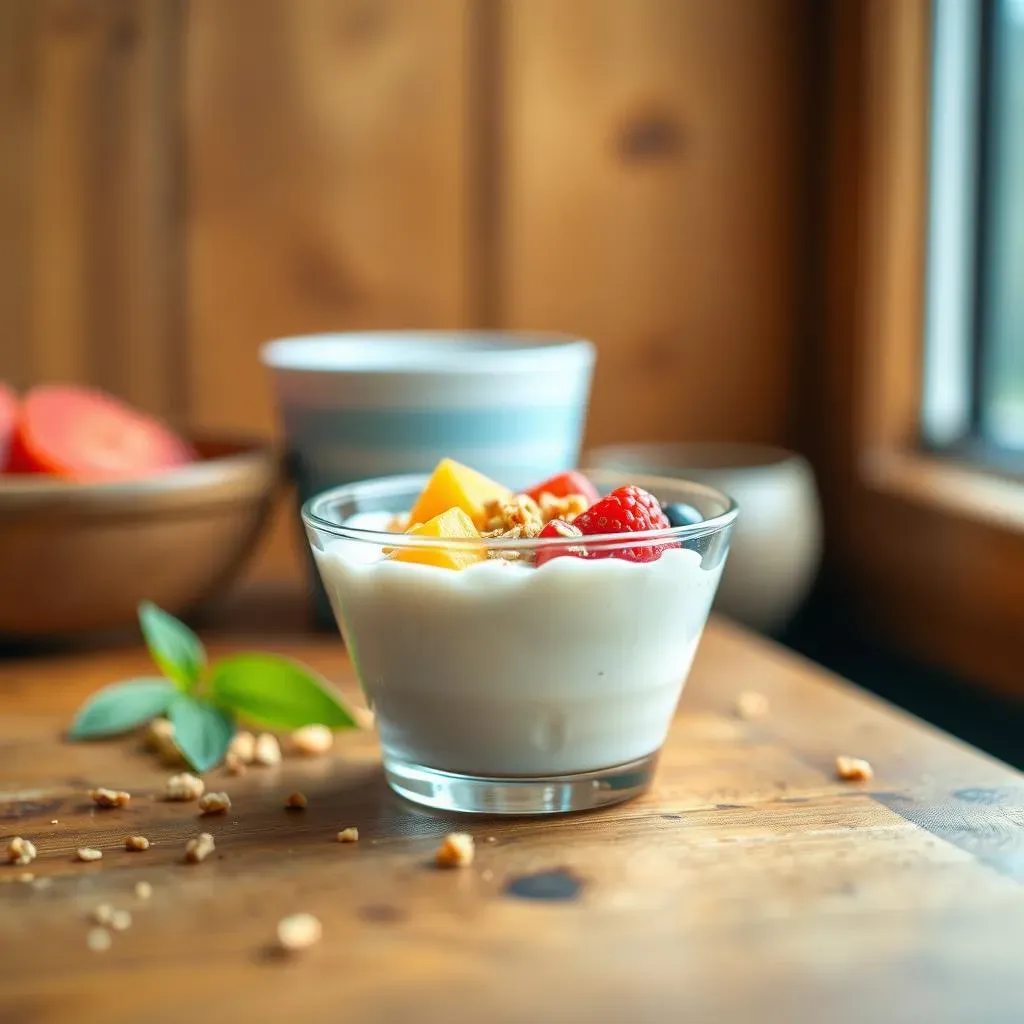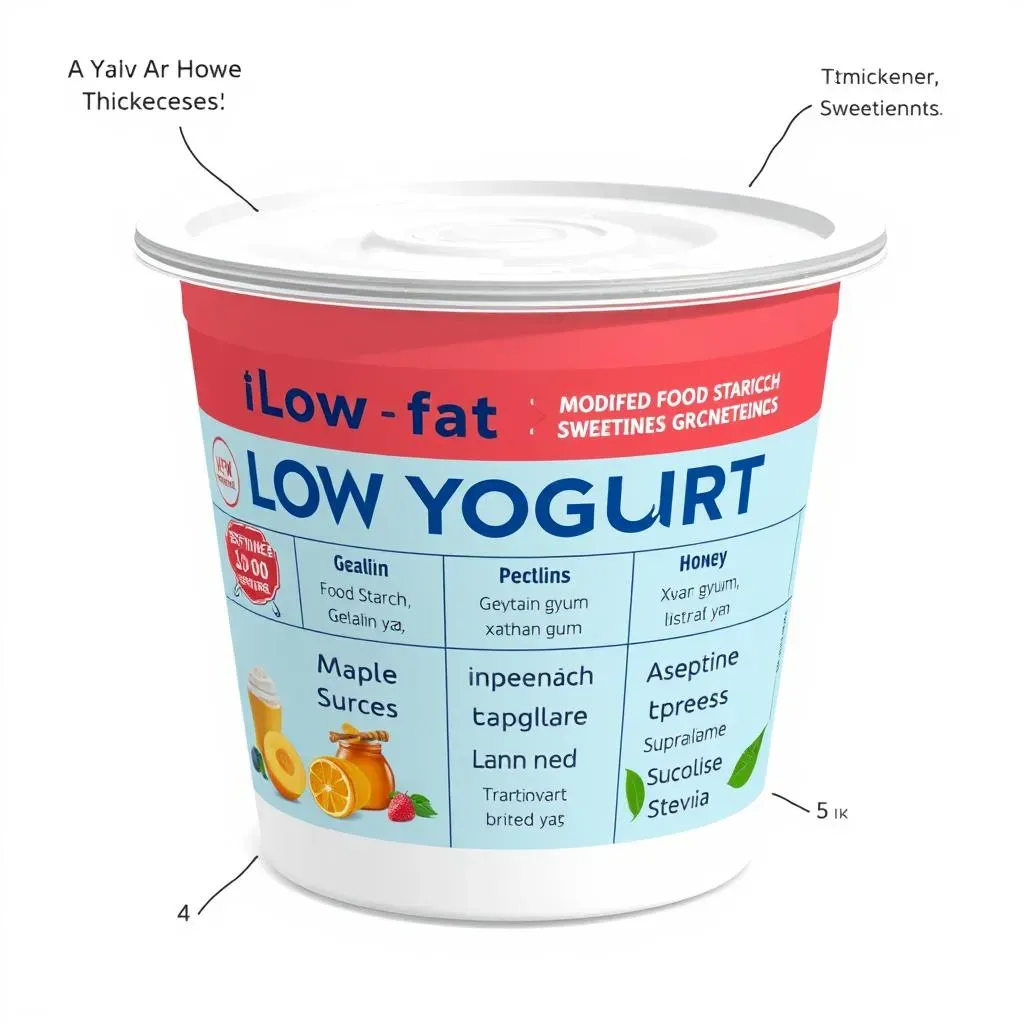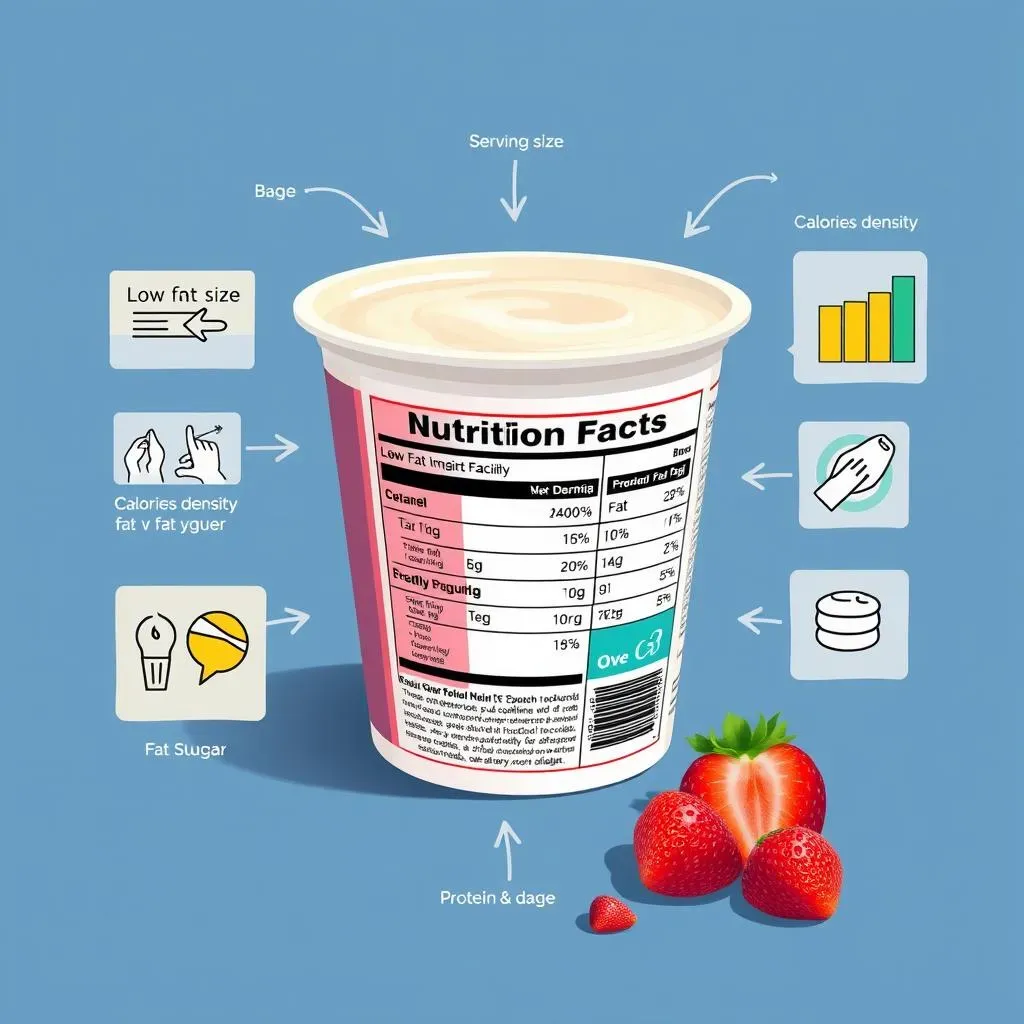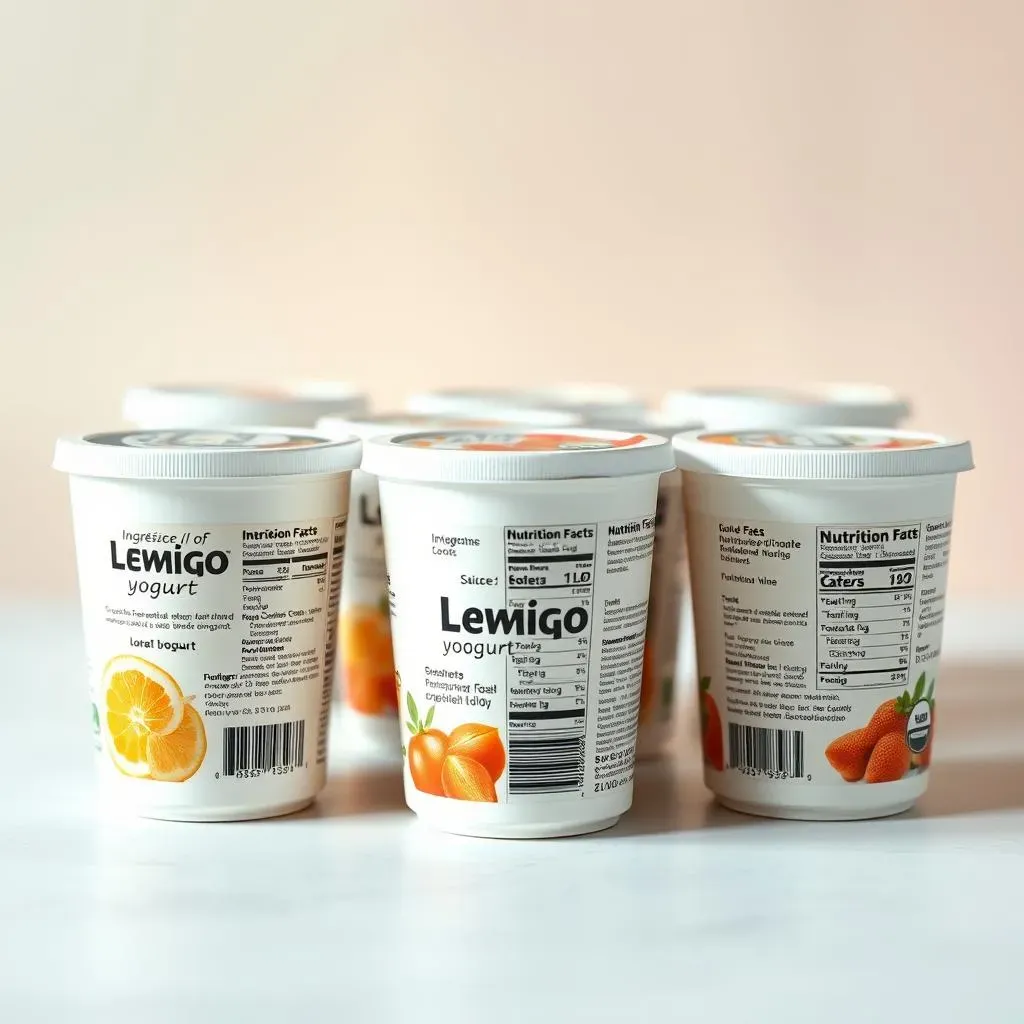Table of Contents
Navigating the yogurt aisle can feel like decoding a secret language, especially when you're trying to make a healthy choice. Low fat yogurt seems like a simple, guilt-free option, but what exactly are the low fat yogurt ingredients that make it so? Are they all created equal? This article dives deep into the world of low fat yogurt, separating fact from fiction and helping you understand what you're truly spooning into your bowl. We'll explore the fundamental components like milk and cultures, uncover the roles of common additives such as thickeners and sweeteners, and teach you how to decipher nutrition labels. Whether you're a seasoned yogurt aficionado or just starting your journey towards healthier eating, this guide will equip you with the knowledge to make informed decisions. Plus, we'll even touch on the rewarding experience of crafting your own low fat yogurt at home, putting you in complete control of the ingredients. Get ready to become a low fat yogurt expert!
Understanding the Basics of Low Fat Yogurt

Understanding the Basics of Low Fat Yogurt
What Exactly IS Low Fat Yogurt?
so you're staring down a wall of yogurt cups, right? "Low fat" screams healthy, but what does it really mean? Simply put, low fat yogurt has had most of the milk fat removed. The FDA says it needs to have less than 3 grams of fat per serving. This can make it a go-to for folks watching their calorie intake or saturated fat levels. It's not just about taking fat out though; it's about what happens after that matters too. Some brands compensate for the lost richness with added sugars or thickeners, so it's crucial to peek at that ingredients list.
Think of it like this: regular yogurt is like whole milk, creamy and rich. Low fat yogurt is like 1% or 2% milk – lighter, but sometimes needing a little help to taste good. That "help" can come in the form of fruit purees, honey, or even artificial sweeteners. The goal is to find a balance: a yogurt that's low in fat but also not loaded with unnecessary extras. It's a quest, but a worthwhile one for your health!
The Health Perks (and Potential Pitfalls)
Let's be real, low fat yogurt gets a lot of hype for being a health food. And for good reason! It's often packed with protein, which keeps you feeling full and helps build muscle. Plus, it's a great source of calcium for strong bones. And don't forget those probiotics – the friendly bacteria that can boost your gut health. But here's the catch: not all low fat yogurts are created equal.
Some brands sneak in a ton of added sugar to make up for the lack of fat, turning a healthy snack into a dessert bomb. Other times, they use artificial sweeteners, which might be calorie-free but can have their own set of potential drawbacks. The key is to be a savvy shopper. Read those labels, compare brands, and choose options that are low in added sugar and made with simple, recognizable ingredients. Your body will thank you for it!
Nutrient | Benefit | Potential Pitfall |
|---|---|---|
Protein | Keeps you full, builds muscle | N/A |
Calcium | Strong bones | N/A |
Probiotics | Gut health | May vary depending on the specific strains and amount |
Added Sugar | Makes it taste sweeter | Can negate health benefits, contribute to weight gain |
The Key Low Fat Yogurt Ingredients: Milk and Cultures

The Key Low Fat Yogurt Ingredients: Milk and Cultures
The Milk Matters: From Cow to Cup
Alright, so let's get down to the nitty-gritty. You can't have yogurt without milk, right? And when it comes to low fat yogurt, the type of milk used is super important. Most brands start with pasteurized low fat milk, which means it's been heated to kill off any bad bacteria. But here's where it gets interesting: the quality of that milk can vary a lot. Some yogurts use milk from cows raised on organic farms, while others use conventional milk. Organic milk often comes from cows that are grass-fed and not treated with hormones or antibiotics, which some people prefer.
Also, some brands use ultra-filtered milk, which removes even more of the lactose (milk sugar) and whey protein. This can result in a thicker, creamier yogurt with a higher protein content. Whether it's organic, conventional, or ultra-filtered, the milk is the foundation of your low fat yogurt, so it's worth paying attention to where it comes from!
The Culture Club: Good Bacteria in Action
milk is the base, but the real magic happens with the cultures. Yogurt is made by adding live and active cultures (aka good bacteria) to milk, which then ferment the lactose and turn it into lactic acid. This process is what gives yogurt its tangy flavor and thick texture. The most common cultures you'll find in yogurt are Streptococcus thermophilus and Lactobacillus bulgaricus. These guys are the workhorses of yogurt-making, and they're what make it, well, yogurt!
But many brands also add other probiotic strains, like Bifidobacterium or Lactobacillus acidophilus, which are known for their potential gut health benefits. Here's the thing: not all yogurts have the same amount or variety of these probiotics. Some yogurts are heat-treated after fermentation, which kills off the live cultures. So, if you're looking for the gut-boosting benefits of yogurt, make sure the label says "live and active cultures." It's like a tiny party in your gut, and you want to make sure the guests are actually alive!
Common Additives in Low Fat Yogurt: Thickeners and Sweeteners

Common Additives in Low Fat Yogurt: Thickeners and Sweeteners
The Thick of It: Why Thickeners Are Added
so you've got your low fat milk and your cultures doing their thing. But sometimes, that's not enough to get that creamy, satisfying texture we all crave. That's where thickeners come in. When the fat is reduced, the yogurt can become thinner and more watery, so manufacturers often add ingredients to boost the viscosity and make it more appealing. Think of it like adding a little cornstarch to a sauce to make it richer – same idea!
Common thickeners you might spot on the label include modified food starch, gelatin, pectin, guar gum, and xanthan gum. These ingredients work by binding water and creating a gel-like structure. While they're generally considered safe, some people might experience digestive issues with certain thickeners, like guar gum. Plus, some folks prefer to avoid heavily processed ingredients altogether. So, it's all about knowing what you're putting in your body and making choices that align with your preferences.
Sweet Surrender: The Lowdown on Sweeteners
Let's face it, plain low fat yogurt can be a bit... tart. To make it more palatable, many brands add sweeteners. Now, this is where things can get a little tricky. Some yogurts are sweetened with natural options like honey, maple syrup, or fruit purees. These are generally considered better choices because they also provide some nutrients and antioxidants. However, they still contribute to added sugar intake, so it's important to be mindful of the amount.
On the other hand, many low fat yogurts are sweetened with artificial sweeteners like aspartame, sucralose, or stevia. These sweeteners are calorie-free or very low in calories, which can be appealing to people watching their weight. However, there's ongoing debate about the potential long-term health effects of artificial sweeteners. Some studies suggest they might disrupt gut bacteria or increase cravings for sweet foods. Ultimately, the best sweetener is the one you feel good about eating in moderation. Or, better yet, try sweetening your yogurt yourself with fresh fruit or a drizzle of honey!
Sweetener Type | Examples | Pros | Cons |
|---|---|---|---|
Natural Sweeteners | Honey, Maple Syrup, Fruit Purees | Provide some nutrients, more natural | Contribute to added sugar intake |
Artificial Sweeteners | Aspartame, Sucralose, Stevia | Calorie-free or very low in calories | Potential long-term health effects, may affect gut bacteria |
Decoding the Nutrition Label: What to Look for in Low Fat Yogurt Ingredients

Decoding the Nutrition Label: What to Look for in Low Fat Yogurt Ingredients
Serving Size and Overall Calories
Alright, grab that yogurt cup and let's get real with the nutrition label. First things first: serving size. Don't be fooled by the big, bold numbers on the front! Those are often based on a tiny serving that nobody actually eats. Check the serving size at the top of the label and ask yourself, "Is this how much I actually eat in one sitting?" If not, you'll need to adjust all the other numbers accordingly. Once you've got the serving size sorted, take a look at the calories. This will give you a sense of the overall energy you're getting from the yogurt. Remember, calories aren't the enemy, but it's good to be aware of how they fit into your daily goals.
Also, consider the calorie density. Is it giving you a lot of nutrients for the number of calories, or are you mostly getting empty calories from added sugar? A good rule of thumb is to aim for yogurts that pack a nutritional punch without being too high in calories. It's all about getting the most bang for your buck when it comes to nutrients!
- Serving Size: Match it to your actual consumption.
- Calories: Consider the overall energy content.
- Calorie Density: Aim for nutrient-rich options.
Fat, Sugar, and Protein: The Big Three
Now, let's zoom in on the macronutrients: fat, sugar, and protein. Since we're talking about low fat yogurt, let's tackle that first. Check the "Total Fat" line and make sure it's in the low fat range (less than 3 grams per serving, according to the FDA). But don't stop there! Look at the "Saturated Fat" content too. Saturated fat is the kind that can raise your cholesterol levels, so it's best to keep it in check. Next up: sugar. This is where things can get sneaky. Look for "Added Sugars" on the label. This tells you how much sugar has been added to the yogurt beyond the natural sugars found in milk (lactose). Aim for yogurts with the lowest amount of added sugar possible. Finally, protein. This is the good stuff! Protein keeps you feeling full and helps build muscle. Look for yogurts with a higher protein content to maximize the benefits.
Think of it like a balancing act: low in fat and added sugar, high in protein. That's the sweet spot for a healthy low fat yogurt. And remember, it's okay to indulge in a sweeter yogurt every now and then, but try to make it the exception, not the rule.
Macronutrient | What to Look For | Why It Matters |
|---|---|---|
Total Fat | Less than 3 grams per serving | Keeps it in the "low fat" category |
Saturated Fat | As low as possible | Can raise cholesterol levels |
Added Sugars | The lowest amount possible | Avoids unnecessary sugar intake |
Protein | The highest amount possible | Keeps you full and builds muscle |
Making Your Own: DIY Low Fat Yogurt and Ingredient Control

Making Your Own: DIY Low Fat Yogurt and Ingredient Control
The Allure of DIY: Total Ingredient Transparency
so you've been scrutinizing those yogurt labels, and maybe you're feeling a little... skeptical? I get it! That's where the magic of DIY yogurt comes in. When you make your own low fat yogurt, you're in complete control of every single ingredient. No more wondering about hidden additives or questionable sweeteners. You know exactly what's going into your body, and that's a pretty empowering feeling. Plus, it's surprisingly easy! All you need is a few basic ingredients and a little bit of patience.
Think of it like this: store-bought yogurt is like ordering takeout – convenient, but you don't always know what you're getting. DIY yogurt is like cooking from scratch – you get to choose the freshest, healthiest ingredients and customize it to your exact liking. And trust me, the taste of homemade yogurt is on another level. It's tangier, creamier, and just plain better than anything you can buy in the store.
- Complete control over ingredients
- Avoidance of unwanted additives
- Customizable to your taste preferences
- Superior flavor compared to store-bought yogurt
The Simple Steps to Homemade Low Fat Yogurt
Ready to dive in? Here's the basic process for making your own low fat yogurt: First, you'll need some low fat milk (duh!). You can use regular low fat milk from the store, or get fancy with organic or even ultra-filtered milk. Next, you'll need a yogurt starter, which contains those essential live and active cultures. You can buy a starter online or at some health food stores, or you can even use a few tablespoons of plain, live-cultured yogurt from the store as your starter. Heat the milk to 180°F (82°C), then let it cool down to 110°F (43°C). This is important because if the milk is too hot, it will kill the cultures. Stir in the yogurt starter, then pour the mixture into a clean container. Keep it warm (around 100-110°F) for 6-8 hours, and voila! You've got yogurt!
You can use a yogurt maker, an Instant Pot with a yogurt setting, or even just wrap the container in a towel and leave it in a warm place. Once the yogurt has set, chill it in the refrigerator for a few hours to stop the fermentation process and thicken it up. And that's it! You've made your own low fat yogurt. Now you can get creative with toppings like fresh fruit, granola, or a drizzle of honey. The possibilities are endless!
Troubleshooting and Tips for Yogurt Perfection
so maybe your first batch of homemade yogurt wasn't exactly perfect. Don't worry, it happens! Here are a few common issues and how to fix them: If your yogurt is too thin, it could be because the milk wasn't heated to a high enough temperature, or the incubation time was too short. Try heating the milk a bit hotter next time, or let it incubate for a longer period. If your yogurt is too sour, it could be because it incubated for too long, or the temperature was too high. Try shortening the incubation time, or lowering the temperature slightly. And if your yogurt is grainy, it could be because the milk was overheated. Be sure to use a thermometer to monitor the temperature carefully.
Also, experiment with different types of milk and starters to find what works best for you. Some people prefer the taste of organic milk, while others find that ultra-filtered milk makes a thicker yogurt. And don't be afraid to try different probiotic strains in your starter. Each strain has its own unique benefits and flavor profile. With a little practice, you'll be making perfect low fat yogurt every time!
Problem | Possible Cause | Solution |
|---|---|---|
Too Thin | Milk not heated enough, short incubation | Heat milk higher, longer incubation |
Too Sour | Long incubation, high temperature | Shorten incubation, lower temperature |
Grainy | Milk overheated | Use a thermometer, monitor temperature |
Making Informed Choices About Low Fat Yogurt Ingredients
Ultimately, understanding the ingredients in your low fat yogurt empowers you to make choices that align with your health goals and dietary preferences. By looking beyond the "low fat" label and scrutinizing the ingredient list, you can select yogurts that are not only delicious but also contribute to a balanced and nutritious diet. Whether you opt for store-bought varieties or embark on the adventure of making your own, knowledge is your greatest asset in navigating the world of low fat yogurt.
